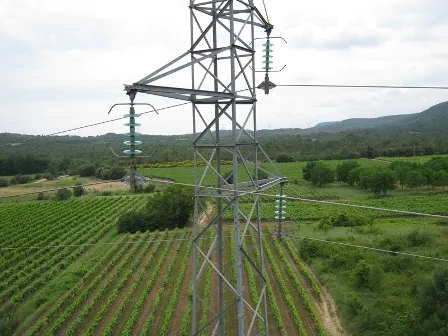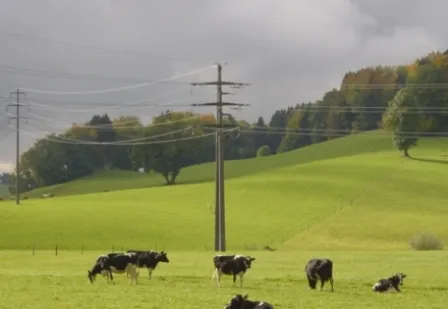The security zone of power lines is a zone located on both sides of the power line, in the form of a piece of land, a body of water, which also includes the air space above this area. The size of the security zone depends on the location of the power line (along the land, across a body of water), its design (cable or overhead), purpose (power line or communication line), and voltage class of the line. Let us give the size of the boundaries of the security zones of cable and overhead lines depending on the given criteria.
The protection zone of overhead power lines passing over land varies depending on the voltage of these lines. For overhead lines with voltage up to 1000 V, including communication lines, the security zone is a land plot and air space along the line along its entire length, at a distance of at least two meters on both sides of this line; for high-voltage overhead lines of voltage class 6 and 10 kV, this distance is 10 m; for overhead lines 35 kV – 15 m; for overhead lines 110 kV – 20 m, etc.
For cable power lines laid in the ground, the security zone is one meter from the place where the outermost cable is laid, regardless of its voltage. For a cable communication line, this distance is 2 m.
Both overhead and cable lines along their entire length can pass through various bodies of water, while the security zone also extends to these sections of the power line. For overhead lines that pass through non-navigable bodies of water, the size of the security zone is the same as in other sections of this overhead line passing on land. When the line passes through navigable bodies of water, the security zone, regardless of the voltage level, is 100 m.
The protection zone of cable lines laid along the bottom of reservoirs is in all cases 100 m.

Human activity in the power transmission line protection zone
Why was the concept of a security zone for power lines introduced? First of all, to ensure the safety of people about possible electric shock, and injury in the event of damage to this line, as well as to prevent the possible negative impact of electromagnetic radiation on the human body.
By statistics and research results, it has been established that the prolonged presence of a person within the security zone of power lines leads to disruption of the activity of the cardiovascular, nervous, endocrine, neurohormonal, immune and other systems and organs of the human body.
The construction of any buildings and structures is prohibited in the power transmission line protection zone. At the same time, land plots along which power lines run are not confiscated from the owners; they can be exploited, but with certain restrictions, depending on local conditions and the type of lines passing through.
For example, if a cable line runs through the territory of a land plot and the owner of this land plot plans to carry out excavation work, then he must take into account that it is prohibited to carry out this work within the security zone of the passing cable line.
If the land plot will be used for growing crops, one should take into account the fact that the power line passing through the territory of the plot may be damaged and the repair team, eliminating the damage that has occurred, will render part of the crops unusable.
The restriction of activities in the security zone of the lines is due not only to the safety of people but also to the need to prevent possible damage to the lines and disruption of their normal operation. Below are the restrictions on activities within the protection zone of power lines.
When preparing documents for a new plot of land along which a power line runs, or when planning any work, it is necessary to obtain permission from the organization that maintains these electrical networks. Particular attention should be paid to cable lines, which are very often discovered only if they are accidentally damaged during excavation work on the site.

Rules for staying in the security zone of power lines
If we talk about the dangers of electromagnetic radiation from power lines, then in this case, the further a person is from the power line, the less he is exposed. Therefore, it is necessary, if possible, to stay as far as possible from passing high-voltage power lines or to reduce the time spent in the area of possible electromagnetic radiation.
Power lines carry a mortal danger, especially high-voltage power lines. Therefore, when near power lines, you should adhere to the following safety rules.
It is forbidden to approach a bare wire lying on the ground, as there is a high probability that it is live. If a person comes within eight meters of the wire, he or she will be exposed and receive an electric shock. If the wire is less than 8 m from a person, then you should leave the dangerous area, moving in a “goose step” without lifting your legs from one another.
You should also remember that there is such a thing as the permissible distance to parts of the electrical installation that are under operating voltage. For example, if exposed wires sag excessively, a person will be shocked by an electric shock when approaching them at an unacceptable distance.
It is prohibited to approach power lines that are in disrepair or have signs of damage. For example, if crackling sounds are heard and an electric arc is visible, then the line can be damaged at any time and cause harm to a person.
